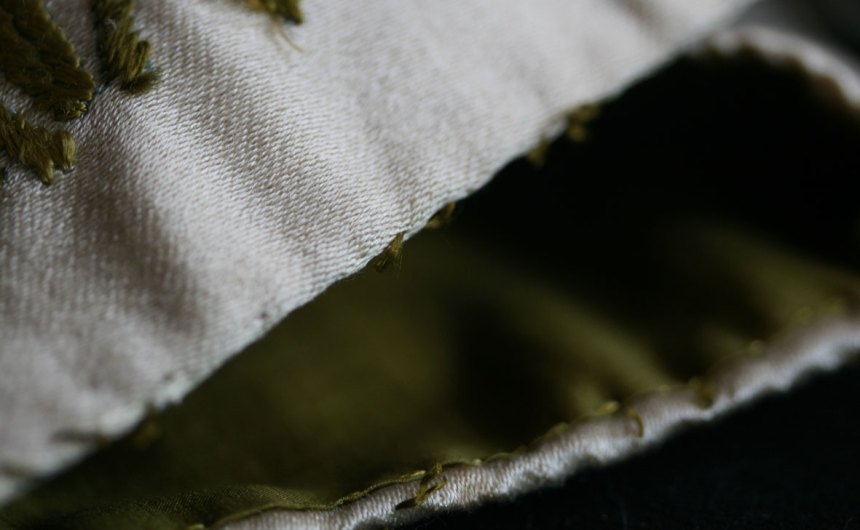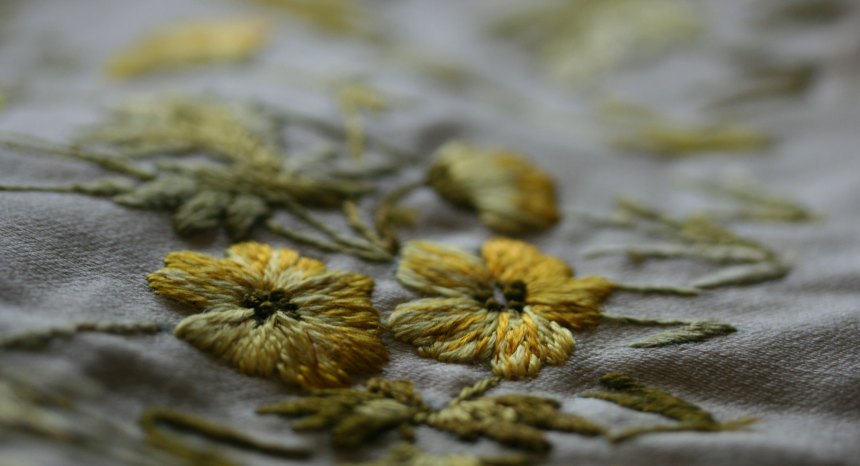When thinking about process, there is nothing more instructive than unpicking someone else’s stitches.
I found a beautiful hand-embroidered cloth on ebay. I have plans for it. The plans involve deconstructing and transforming it into something else. I began by undoing the slip stitches of its heavy, worn cord edging.
Then I started to unpick the tiny stitches which attach the embroidered front to the cloth’s very fine silk back. The silk is faded but luminous, alive with copper and green.
The secrets written in the cloth began to reveal themselves. Neatly folded hems. Pale green silk thread that moved through the cloth like clockwork. An outer layer of heavy cotton satteen. An inner layer of lining satteen, fresh and bright because unseen for decades. Embroidery worked through both layers. Each thread end carefully woven and hidden. The back of the work faultless in its steady execution.
. . .and just as mesmerising as the front.
It was then that my fascination with the little mysteries of this cloth changed into a something else. I felt a sense of privilege and respect — in unpicking the stitches I was re-living the work of their making, admiring the skill of a talented needlewoman. But my act was also one of trespass: me and my snipping embroidery scissors were destroying a once-whole thing. And as I, blithe, curious, surgeon-like, began to examine the cloth’s insides, I uncovered the truth of its age: the satteen was of a certain kind, and a little older than I’d imagined. I was an historical vandal, cutting through the threads of time.
In cutting someone else’s threads, as in wearing someone else’s clothes, there is the frisson of encounter. We don’t know and will never know the person who made or wore the thing, but they are speaking to us nonethless, in the movement of their hand through the stitches, or in the the shape of their body left in the garment. There is something deeply uncanny in the silence of cloth and clothes: the trace of an unknown and never-to-be-known physical presence. (One does not buy second hand shoes, because one shies away from the ghost of the foot inside.) As I unpicked the stitches, then, a simple encounter between me and the cloth changed into a more complex one between me and its maker. Because I was un-making a made thing my act seemed an intimate one, but it was an empty intimacy, an intimacy with no content. The embroidered cloth was both speaking and not speaking: of a someone living in those stitches and of the silence of the grave.
Wallace Stevens’ brilliant poem, The Emperor of Ice Cream, (1922) has much to say about the dumb intimacy of embroidery — and of death. Stevens describes the covering of a woman’s corpse with a cloth she embroidered when alive.
Take from the dresser of deal,
Lacking the three glass knobs, that sheet
On which she embroidered fantails once
And spread it so as to cover her face.
If her horny feet protrude, they come
To show how cold she is, and dumb.
Let the lamp affix its beam
(lines 9 – 15)
Here the corpse is, like the cloth she embroidered, an everyday material object. She reminds us of death’s easy finality. Yet she also suggests the mute compassion of the world of things. We feel the weight of her hands on the lost knobs of the well-worn dresser; her fingers quick movement through the stitches of the cloth that decorates her dead countenance. She does not speak, all we can know is her corpse and her cloth. And it is in the relationship between these two material objects that the essence of the poem (perhaps another object in itself) lies. Gaudy embroidered fantails will never cover death, but each small act of making is an end in itself, capturing the (perhaps pointless) vitality of the human. Now get back in the kitchen (says Stevens) and enjoy your ice-cream.
Having unpicked my thoughts I will get on with the uncanny work of unpicking.







There is melancholy and celebration in unpicking another’ handiwork. As I unpick and unravel hand knitted garments to re-use the wool, I am often sad at destroying this evidence of another’s effort. Throughout, though, I celebrate her talent, skill, care and love in the object’s creation. I like to think, too, that the creator would approve of it’s recreation rather than is abandonment.
LikeLike
i’m reading this…
http://www.amazon.com/Stitching-Rites-Colcha-Embroidery-Northern/dp/0816520291
….as i’m moving to NM, and it is anthropology. they offer colcha classes at the art center and i will be there.
yours is archaeology and also entering into the ritual with the maker of the cloth, a kind of intimacy only the restorer/repurposer knows. fascinating.
LikeLike
Mm, I’ve totally felt this when blocking someone else’s shawl – there is a silence and unexpected intimacy between the stitches that you uncover as you work.
LikeLike
Wow. You are a beautiful writer. I feel inspired.
LikeLike
It takes a maker to appreciate what someone else has made, doesn’t it? More photos of this emroidered wonder, please. :)
LikeLike
Honestly, I sometimes wish I could reach through my computer, change your camera to “wide,” and get a good honest look at the rest of whatever you are photographing.
LikeLike
Wonderful, thank you.
LikeLike
very lovely; both the prose and the embroidery
LikeLike
If you like Wallace Stevens then you might enjoy reading Sam Swope’s account of sharing Stevens’ ‘Thirteen Ways of Lookng at a Blackbird’ with a class of American ten year olds. It appears in Swope’s book which recounts a year working with these children ‘I Am A Pencil’, but can also be read online at:
http://www.samswope.org/work2.htm
Swope is the sort of teacher you wish you could clone.
LikeLike
Wonderfully written!!
LikeLike
Thank you, Kate, you continue to put into lovely words – many of our thoughts.
LikeLike
Beautifully said.
As the leading textile freak in my generation, I have begun to inherit textile items from my husband’s family and my own. It’s a wonderful connection to women I will never know.
LikeLike
Kate you have a lovely gift for words, in all your post but especially in this one. Thanks, you are able to make the invisible visible again. I have a weakness for vintage handmade textiles, and although I am trying to limit my collection due to space reasons, I am always drawn to the hopes and dreams of that woman somewhere who made something so lovely.
LikeLike
Completely stunning stuff, in all respects. S.
LikeLike
It seems that an hierloom piece captures a more pleasant side of death. They are about preserving memories and helping them to reach the next generation.
LikeLike
so glad I found my way here. through many changes in the past year, I find myself going through my mother’s unfinished needle work. some things will be finished, some will be abandoned, some will be preserved as is. I don’t think anything touched me as much as finding her stash of old thimbles, especially a battered one, old enough to have been my grandmother’s that fits my fingertip perfectly.
LikeLike
Beautifully written!
I’ve inherited / been given a fair amount of heirloom textiles from my family and my husbands as they know that I’ll appreciate them. (As a teen I was a tour guide/living history demonstrator at Watkins Woolen Mill State Historic Park – for 4 years.) It’s a great honor to hold these beautiful things in my hands, knowing both the great work that went into the making and the great reverence in years of care for the item.
LikeLike
Wow!
I think i can empathise a wee bit about what you are saying – looking through mum’s stuff after she died and finding half-finished work i feel compelled to finish it – not because I particularly want to but through respect for the efforts that she put in to doing these things – in particular a rug that she had been working on and tells so much of her life – using up and making do and transforming the ordinary into something useful and – somethimes – beautiful but always done with love.
LikeLike